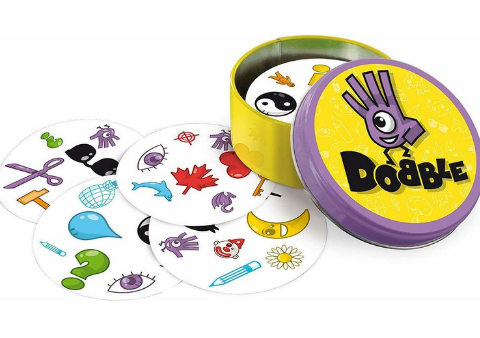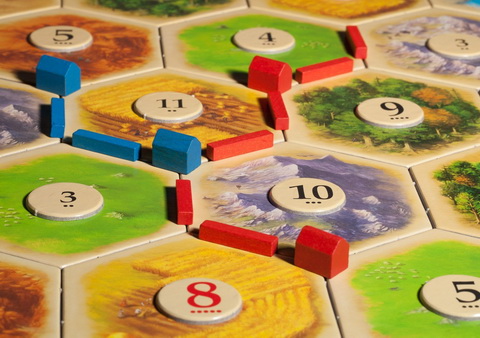Let's Bet Party is a game for those who like to laugh, challenge themselves, improvise and have fun. Try the party version, where you can not only complete tasks, but also act and hope your partner guesses quickly. Here are the rules for the game. For more party games, check out here.

Game set
- 1 game board;
- 288 task cards;
- 12 "yes" and "no" cards;
- play money;
- 6 game pieces;
- 36 markers;
- 1 die;
- 3 hourglasses.
Frequently asked questions
❓ How many people can play the Bet Party version?
There must be more than three players.
❓ From what age can I play this game?
Let's Bet Game (party version) is suitable for people aged 15 and over.
Let's Bet Game - Party version. Destination
Raise as much money as possible. This can be obtained either by winning a bet or by completing a task.
Preparing for the game
- Each player is dealt 80 Play Money;

- Distinction is made between role-play, active and passive task cards. They are mixed;
- Each player receives 1 "yes" and 1 "no" card;

- A game piece is selected and placed on the game board in the starting square;
- All players take markers of the same colour as their opponents' pieces. The number of markers to be taken is equal to the number of opponents in the game;
- When more than 6 people are playing, you need to form teams.
Let's Bet Game (party version) is on
As you may have noticed, there are three different coloured hourglasses: yellow - 15 seconds; red - 30 seconds; black - 60 seconds.  The youngest player starts the game. The tasks in this game are either individual or for two people.
The youngest player starts the game. The tasks in this game are either individual or for two people.
The first player rolls the dice and passes through as many boxes as the number of eyes rolled. Next, we will discuss how to behave when standing on one or the other box:
"Go" 
When you pass this box, you are awarded 50 Play Money.  Once you are on this square, you can roll the dice again.
Once you are on this square, you can roll the dice again.
Acting task 
When a person stands on this box, he can choose his mate. This is done by pointing to one of the coloured markers in front of him.
Once used, the marker can no longer be used and should be put to one side.
Once a pair has been chosen, one player takes a role card and looks at the task to be performed.
All the playing cards are made up of sentence starters and sentence enders. The beginning is represented by numbers and the end by letters. To find out what specific task you need to do, look at the box on the board you are standing on. There will be a specific number and a letter.
The player who drew the card reads out what he or she will do and shows the card to all other opponents. Except for the two who will have to perform the task.
Bets:
Non-playing players bet on whether they can complete the task. They place cards on the table, face down, with a 'yes' or 'no'. They choose the appropriate card at their discretion. No more than half of the available amount can be wagered.
The card is now given to the player who completes the task. He/she reads what it says and prepares to act. His partner cannot see what is written on the card.
Decide who will monitor the time. That person will have to turn the red hourglass over three times. This will give a total of 90 seconds to complete the task. After the third time the sand has been completely covered, the player has to shout "time". Then the player must stop playing and guessing.
The acting and guessing starts as soon as the hourglass is turned over for the first time.
Wins:
- If the other player guesses the whole sentence, both players get as much money as is on the table;
- Players who guessed whether the task will be completed withdraw their money and receive an equal amount from the bank. The money wagered by players who did not guess goes to the bank.
The used card should be placed at the bottom of the pile. The game continues in a clockwise direction.
Active tasks 
The person who stands on this box has a task to complete. The opponent to that player's left takes one card from the top of the deck of 'active' cards. He then reads the task aloud.
Bets:
Everyone is starting to bet on whether it will be feasible. They put cards on the table, face down, with a "yes" or "no". They choose the right card at their discretion. No more than half of the available amount can be bet.
When you see an hourglass of a particular colour on the card, that's the hourglass you'll have to use in this case.
Wins:
- If the player completes the task, he/she receives as much money as is placed on the table.
- Players who guessed whether the task will be completed withdraw their money and receive an equal amount from the bank. The money wagered by players who did not guess goes to the bank.
The used card should be placed at the bottom of the pile. The game continues in a clockwise direction.
Passive tasks 
In this case, one of the opponents draws one card from the top of the 'passive' deck. All players read what it says. Whoever has to perform the task must not show this card until the betting is over. When everyone has bet, the card is then given to the person who will be doing the task and they must do it as quickly as possible. If a particular hourglass is shown on the card, that is the one to be used. Bets and wins/losses similar to the Active Task.
Blind betting box 
In this case, the player can choose whatever task they want: active, passive or role-play. The main difference is that you have to bet blindly, without knowing which task will be drawn. The card can only be turned face up when all opponents have built. Wins/losses similar to the Active Task.
The dice challenge box 
The player chooses the opponent against whom they will play in this round. The two people bet on who will roll the higher number and then roll the dice. The bet can be placed on an amount of your choice. The player whose guess is correct gets back the money they have bet and gets the same amount back from the bank. If the person who was supposed to do the task does not guess, then he gives his money back to his opponent. If the person he chose doesn't guess, he just takes his money back.
Box with arrow 
After landing in this square, the die is rolled again
Let's Bet Game (party version) is over
Game ends when someone has used their last marker. Then everyone has to count their money. Whoever has the most wins.
Tips for the role player
- It is better to play without using your voice. But if all players agree otherwise, you can make certain sounds. Most importantly, you cannot speak;
- Don't worry if you look stupid. Make full use of your body language and gestures;
- You can use your fingers to show numbers, e.g. how many words make up a sentence, or which word you will act out;
- A plus sign with two fingers crossed means "and";
- Two claps of the hands are given when the guessing player has to say a synonym;
- When the word is short, show it with your thumb and index finger. Just leave a small space between them;
- You can use two fingers to show that a word is compound. When at least one part of the word is guessed, one finger is covered;
- To get your partner to change the sound of a word, you need to spin the wheels with your hand in the air;
- To use the verb, the speaker must place both hands in front of him/her, palms up;
- You can point to specific objects, but you can't touch them;
- The guessing player has to say as many correct options as possible. It is possible to be wrong. But if he guesses, the person playing will immediately confirm it





